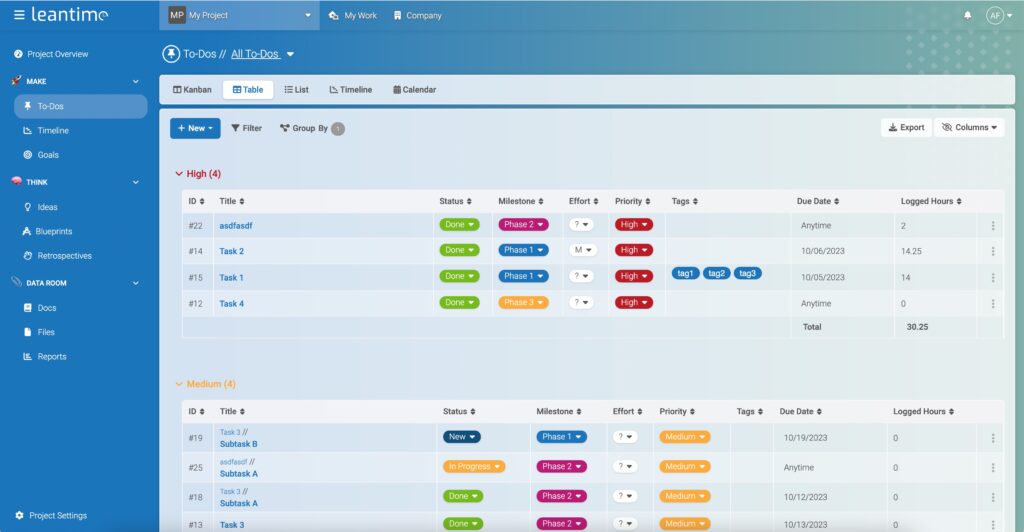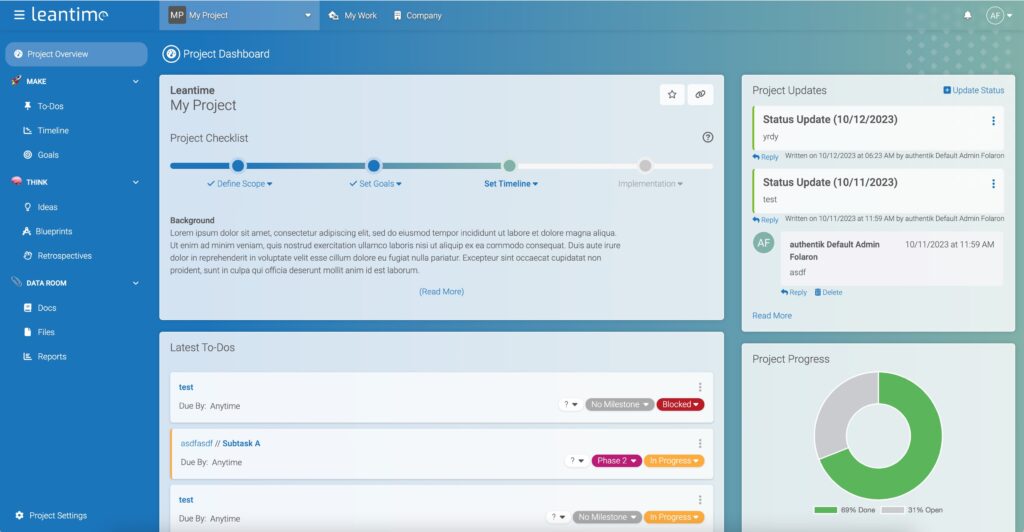Estimated reading time: 12 minutes
Table of contents
- The Importance of agility and structure in software development project management
- Understanding Agility in Software Development
- The Role of Structure in Software Development Project Management
- Practical Strategies for Building Agility and Structure in Software Development
- Benefits of Balancing Agility and Structure
- Challenges and Solutions in Balancing Agility and Structure
- Tips for Balancing Agility and Structure with Dedicated Software Teams
- Conclusion
- Embrace the Project Management Balance with the right tools
The Importance of agility and structure in software development project management
Agility and structure play a vital role in software development project management. Agile methodologies empower teams to adapt to changing requirements, improve collaboration, and enhance customer satisfaction.
In contrast, structure ensures that projects are executed efficiently, resources are allocated effectively, and goals are met consistently. Traditional agile practices in software development typically include structured and process-driven approaches. As more organizations adopt forms of agile principles, a broader approach to the practice has grown.
Challenges faced by project managers in balancing agility and structure
Project managers face numerous challenges in striking a balance between agility and structure, such as managing stakeholder expectations, aligning team goals, and implementing suitable methodologies. Additionally, overcoming resistance to change and ensuring team members possess the necessary skills and knowledge further complicates the process.
For a project manager, understanding what a process looks like inside the agile organization is fundamental and will often look very different across organizations depending on the types of people involved on the team.
Understanding Agility in Software Development
Agility in software development refers to the ability of a project team to adapt to changing requirements, respond to feedback, and deliver value quickly. In this section, we’ll discuss the key principles of agile methodologies, the benefits of incorporating agility in project management, and how Leantime’s approach supports agile practices.
Agile methodologies, such as Scrum, Kanban, and Extreme Programming (XP), emphasize flexibility, collaboration, and customer satisfaction. These methodologies prioritize iterative development, where small increments of work are completed and reviewed frequently. Agile teams focus on delivering a Minimum Viable Product (MVP) as early as possible and then continuously improving it based on customer feedback. This can mean shipping features in the smallest form or even, at times, in a rough form while developing value.
There are several benefits to incorporating agility in project management. Agile teams are better equipped to handle changing requirements and set themselves up to pivot quickly and efficiently. This ensures that the final product meets customer needs. Improved and frequent collaboration among team members increases innovation and problem-solving capabilities. Additionally, agile practices can promote transparency and accountability, ultimately fostering a culture of continuous improvement and learning.
Using free agile project management software

Leantime is an open source project management tool designed to support agile methodologies. Taking a hybrid approach (combining agile, lean methodologies, and design thinking), the system provides features such as Kanban boards, task prioritization, and time tracking. The system also allows teams to work in Sprints.
Where Leantime stands out in its agility, however, is in how quick it is to set up and use. Maintaining agility must include the ability to see where projects, and the work, are quickly. By offering a flexible and user-friendly platform, Leantime enables teams to effectively manage their projects while maintaining the agile principles of adaptability, collaboration, and customer (human) focus.
The Role of Structure in Software Development Project Management
Structure plays a crucial role in ensuring the successful execution of software development projects. It enables teams to maintain control over project timelines, resources, and deliverables while working towards a common goal. In this section, we will discuss the importance of structure, how to incorporate it into agile methodologies, and Leantime’s commitment to providing structured project management solutions.
Effective project management requires a structured approach to planning, executing, and monitoring tasks. A well-defined structure ensures that all team members understand their roles and responsibilities, leading to better coordination and communication. Moreover, a structured approach allows project managers to track progress, identify potential issues, and mitigate risks proactively.
Even more importantly, the structure enables clear communication and expectation management. Having these things gives the team the ultimate framework and standards to work within. By including expectation management as part of the structure process, project managers set a tone for the success of the project.
Incorporating structure into agile methodologies may seem counterintuitive, as agility emphasizes flexibility and adaptability. However, a certain level of structure is necessary to maintain control over the project and achieve desired outcomes. This can be achieved by combining agile practices, such as iterative development and continuous improvement, with structured project management techniques like milestone planning, resource allocation, and risk management.
This approach can be seen in Leantime; which is dedicated to providing structured project management solutions that complement agile methodologies. Leantime takes a structured approach to its project management features by clearly establishing the parts of project management within the tool. The workflows are set and do not require the stress and overthinking of trying to set up the company’s system workflow. When symptoms are overly customizable, they can quickly become overwhelming for individual team members. By striking the right balance between agility and structure, the work management system empowers teams to deliver high-quality software projects on time and within budget.

Striking the Perfect Balance between Agility and Structure
Finding the right balance between agility and structure in software development project management is essential for achieving project success. This balance allows teams to adapt to changing requirements while maintaining control over project progress, resources, and deliverables. In this section, we’ll discuss how to identify the right balance for your software development team, adapt to changing project requirements while maintaining structure, and how Leantime’s strategic project management approach supports this balance.
Identifying the right balance for your software development team
The ideal balance between agility and structure varies depending on factors such as team size, project complexity, and organizational culture. To determine the right balance for your team, consider the following:
- Assess the unique needs and preferences of your team members.
- Examine the project’s goals, constraints, and risk factors.
- Align project management practices with your organization’s strategic objectives.
- Continuously evaluate and adjust the balance based on project performance and feedback.
Adapting to changing project requirements while maintaining structure
As software development projects progress, requirements may change due to evolving customer needs, new technologies, or shifting market trends. It is important to maintain a balance between agility and structure when adapting to these changes. This can be achieved by:
- Regularly reviewing and updating project plans, milestones, and resource allocations.
- Emphasizing clear communication and collaboration among team members and including them in decisions and discussions.
- Implementing agile practices, such as iterative development and continuous improvement, within a structured project management framework.
Practical Strategies for Building Agility and Structure in Software Development
To effectively balance agility and structure in software development project management, it’s essential to implement practical strategies that cater to both aspects. In this section, we will discuss four key strategies to help your team build agility and structure in software development projects.
Aligning team goals and project objectives
Ensuring that team goals and project objectives are aligned is vital for maintaining a balance between agility and structure. This can be achieved by setting clear expectations, defining roles and responsibilities, and establishing a shared understanding of the project’s purpose and desired outcomes. Regularly reviewing and updating team goals and project objectives helps to keep everyone focused and aligned with the overall project vision.
Implementing effective communication channels
Effective communication is crucial for fostering collaboration and adaptability in software development projects. Establishing open and transparent communication channels, such as daily stand-ups, sprint reviews, and retrospectives, helps teams to share information, address challenges, and adapt to changing requirements. Additionally, promoting a culture of open feedback and continuous improvement supports the integration of both agile and structured practices.
Prioritizing tasks and managing project risks
Prioritizing tasks and managing project risks is essential for maintaining structure while embracing agility. Teams should use techniques such as backlog grooming, sprint planning, and risk assessment to identify, prioritize, and manage tasks effectively. Regularly assessing and adjusting priorities ensures that the most important tasks are completed first, while proactively addressing risks helps to keep the project on track and minimize potential disruptions.
AI-based features for enhancing agility and structure in project management
Leantime offers AI-based features designed to support the balance between agility and structure in software development project management. These features include AI-based task prioritization, AI story time, AI status updates and reports, and an AI coach that provides variable rewards for completing tasks. By leveraging these innovative tools, teams can achieve a well-balanced approach to project management, resulting in improved efficiency, productivity, and overall project success.
Benefits of Balancing Agility and Structure
Striking the right balance between agility and structure in software development project management yields several benefits. These benefits include improved project outcomes and customer satisfaction, increased efficiency and productivity, enhanced team collaboration and coordination, and a user-friendly experience for non-project management clients.
Improved project outcomes and customer satisfaction
By effectively balancing agility and structure, teams can deliver software projects that not only meet but exceed customer expectations. Agile practices enable teams to adapt to changing customer needs, while structured project management ensures timely delivery and efficient use of resources. As a result, projects are completed on time, within budget, and with a focus on delivering value to the end-user.
Increased efficiency and productivity
A well-balanced approach to project management allows teams to work more efficiently and productively. Agile methodologies empower teams to prioritize tasks, rapidly respond to feedback, and continuously improve their processes. On the other hand, structure ensures that resources are allocated effectively, and progress is tracked accurately. This combination leads to optimized workflows, reduced waste, and ultimately, increased productivity.
Enhanced team collaboration and coordination
When agility and structure are balanced, team members can collaborate effectively and coordinate their efforts toward a shared goal. Agile practices foster open communication, transparency, and trust, while structure provides a clear framework for roles, responsibilities, and project milestones. As a result, team members can work together seamlessly, even in complex or rapidly changing environments.
Challenges and Solutions in Balancing Agility and Structure
While balancing agility and structure in software development project management offers numerous benefits, it also presents several challenges. In this section, we’ll discuss the common challenges faced by teams and provide solutions to overcome them, including Leantime’s inclusive solutions for individuals with ADHD, ADD, and dyslexia.
Overcoming resistance to change in adopting agile methodologies
One of the primary challenges in balancing agility and structure is overcoming resistance to change among team members. Adopting agile methodologies often requires a significant shift in mindset and work habits. To facilitate this transition, project managers should:
- Communicate the benefits of agile practices to team members.
- Provide training and resources to help team members develop the necessary skills.
- Encourage a culture of openness and continuous improvement.
- Lead by example, demonstrating a commitment to agile principles and practices.
Managing stakeholder expectations and project scope
Another challenge in balancing agility and structure is managing stakeholder expectations and project scope. Agile methodologies prioritize flexibility and adaptation, which can sometimes lead to scope creep or misaligned expectations. To manage stakeholder expectations and project scope, project managers should:
- Establish clear project goals and objectives from the outset.
- Regularly communicate progress and any changes to project scope with stakeholders.
- Implement a structured change management process to ensure that scope changes are evaluated and approved appropriately.
Ensuring team members have the necessary skills and knowledge
For a balanced approach to project management, it’s essential that team members possess the necessary skills and knowledge to effectively implement both agile and structured practices. To ensure team members are equipped for success, project managers should:
- Identify skill gaps and provide targeted training and resources.
- Encourage team members to attend workshops, conferences, and other professional development opportunities.
- Promote a culture of continuous learning and knowledge sharing among team members.
Inclusive solutions for individuals with ADHD, ADD, and dyslexia
Leantime’s project management tool is designed with a focus on inclusivity, providing solutions for individuals with ADHD, ADD, and dyslexia. By offering features that boost dopamine and intrinsic motivation, as well as research-based design for easy reading, Leantime ensures that all team members can effectively contribute to the project management process. This inclusive approach not only supports a diverse team but also promotes a more balanced and successful project outcome.
Tips for Balancing Agility and Structure with Dedicated Software Teams
Successfully balancing agility and structure in software development projects requires a strategic approach, especially when working with dedicated software teams. In this section, we will discuss four key tips to help your team effectively balance agility and structure in your projects.
Establishing clear roles and responsibilities within the team
One crucial aspect of balancing agility and structure is ensuring that all team members have a clear understanding of their roles and responsibilities. This clarity helps to promote accountability, streamline workflows, and maintain a structured approach to project management. By defining roles and responsibilities from the outset and regularly reviewing them, teams can effectively adapt to changing requirements while maintaining a strong organizational structure.
Encouraging continuous learning and skill development
Fostering a culture of continuous learning and skill development is essential for maintaining a well-balanced approach to project management. Encourage team members to attend workshops, conferences, and other professional development opportunities to enhance their understanding of both agile and structured methodologies. This continuous growth enables team members to effectively implement and adapt to the best practices in project management, ultimately contributing to a more balanced and successful project outcome.
Regularly reviewing and adjusting project processes and methodologies
As projects progress and requirements change, it’s essential to regularly review and adjust project processes and methodologies to maintain a balance between agility and structure. This continuous evaluation allows teams to identify areas for improvement, optimize workflows, and ensure that they are effectively responding to changing project needs while maintaining control over project progress, resources, and deliverables.
Conclusion
In conclusion, balancing agility and structure is key to successful software development project management. By adopting agile methodologies and maintaining a structured approach to planning, executing, and monitoring tasks, teams can effectively respond to changing requirements, optimize workflows, and deliver high-quality software projects.
By aligning team goals, implementing effective communication channels, prioritizing tasks, and managing project risks, teams can enhance efficiency, productivity, and collaboration while delivering software projects that exceed customer expectations.
Embrace the Project Management Balance with the right tools
As you’ve learned, balancing agility and structure is key to successful software development project management. Embrace this balance with Leantime, a project management tool designed to cater to various work styles, including small business owners, product teams, and digital consulting agencies. Leantime offers unique features such as AI-based task prioritization, AI story time, and an AI coach that provides variable rewards for completing tasks.
Leantime is a project management tool designed to support you in your efforts to balance agility and structure. With features like Kanban boards, Gantt charts, time tracking, and AI-based task prioritization, Leantime provides a flexible and user-friendly platform that supports agile and structured project management approaches.
- Project Planning & Task Management for ADHD: Trello vs. Leantime
- Lean methodologies are good for Project Management… but you need more
- Top 10 Agile Lifecycle Project Management Tools of 2023
- A simple overview of the 5 most common project management methodologies
- Open Source Project Management Software: What You Need to Know



